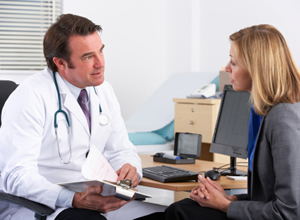Osteoporosis – Are You At Risk?
With osteoporosis your bones become fragile and brittle so that even minor accidents can result in fractures.

There is no doubt that osteoporosis is a disabling disease and not confined to women.
It is estimated that one third of women and 8 per cent of men have a lifetime risk of developing it.
The age at which you lose bone depends on your specific risk factors. One woman might be in her 40s or 50s with very strong bones while another can be in her 30s and have early signs of premenopausal osteoporosis, including fractures.
What is it?
Osteoporosis is a gradual weakening of the bones caused by a reduction in bone density. Unfortunately it has virtually no outward symptoms until it is well established, hence its nickname of the ‘silent killer’.
With osteoporosis your bones become fragile and brittle and so are easily broken. As more severe bone loss occurs, then even minor accidents can result in fractures, most frequently in the spine, wrist, hip and pelvis.
If the condition becomes advanced, and is untreated, then the vertebrae of the spine are prone to compression fractures, which affect surrounding nerves and organs.
This also results in a loss of height for which the old nickname was ‘the dowager’s hump’ as it was frequently seen in the bent over posture of old ladies. It is also accompanied by chronic pain.
Risk Factors
Women are four times more likely than men to develop osteoporosis, and women over 55 are the most susceptible.
Knowing your medical history is important as osteoporosis often runs in families, but if this is not the case for you then it is the declining hormone levels as we age that are an important factor in whether or not you develop osteoporosis.
Both oestrogen and progesterone are essential for bone building and production of both these slow down as we get older. Normal bone tissue is broken down by cells called osteoclasts (a process which needs oestrogen) and rebuilt by osteoblasts (which needs progesterone).
As we age, the rate at which the bone is broken down exceeds that at which it is built up and this leads to bone loss.
Younger women can also be at risk
It can also affect women who have had a surgical menopause through having a hysterectomy and also anyone who has undertaken severe dieting or has a history of anorexia or bulimia.
There is a severe mineral loss involved in these conditions during the teens and twenties and this can do permanent damage to the bones.
Three ways to help reduce the risk
There are a number of ways to deal with osteoporosis and three of the important ones in the prevention and management of this condition are stress management, diet and exercise.
1. Stress management is essential as not only will it make any hormonal symptoms that you have worse, but having a high level for a long time can weaken your bones and make you lose muscle.
2. Your diet really can make a difference and risk increases if yours is high in animal protein, too much salt, heavy metal toxicity, and cigarettes.
3. Exercise is important for so many health reasons and is crucial for managing osteoporosis.
Key exercises include walking, strength training, and weight-bearing, resistance, and balance exercises. These are particularly beneficial for bone density and fall prevention.
However, it is always best to check with your doctor or a physical therapist if you have been diagnosed before you start such a new exercise routine to ensure safety and suitability.
Helpful information:
Being aware of your own risk factors will enable you to take charge of your health and minimise the effect osteoporosis may have on you.
Women need both progesterone and oestrogen for strong bones so achieving hormone balance is key and it helps to have a bone building diet too.
https://anna.blog.wellsprings-health.com/how-your-diet-helps-to-build-strong-bones/


















